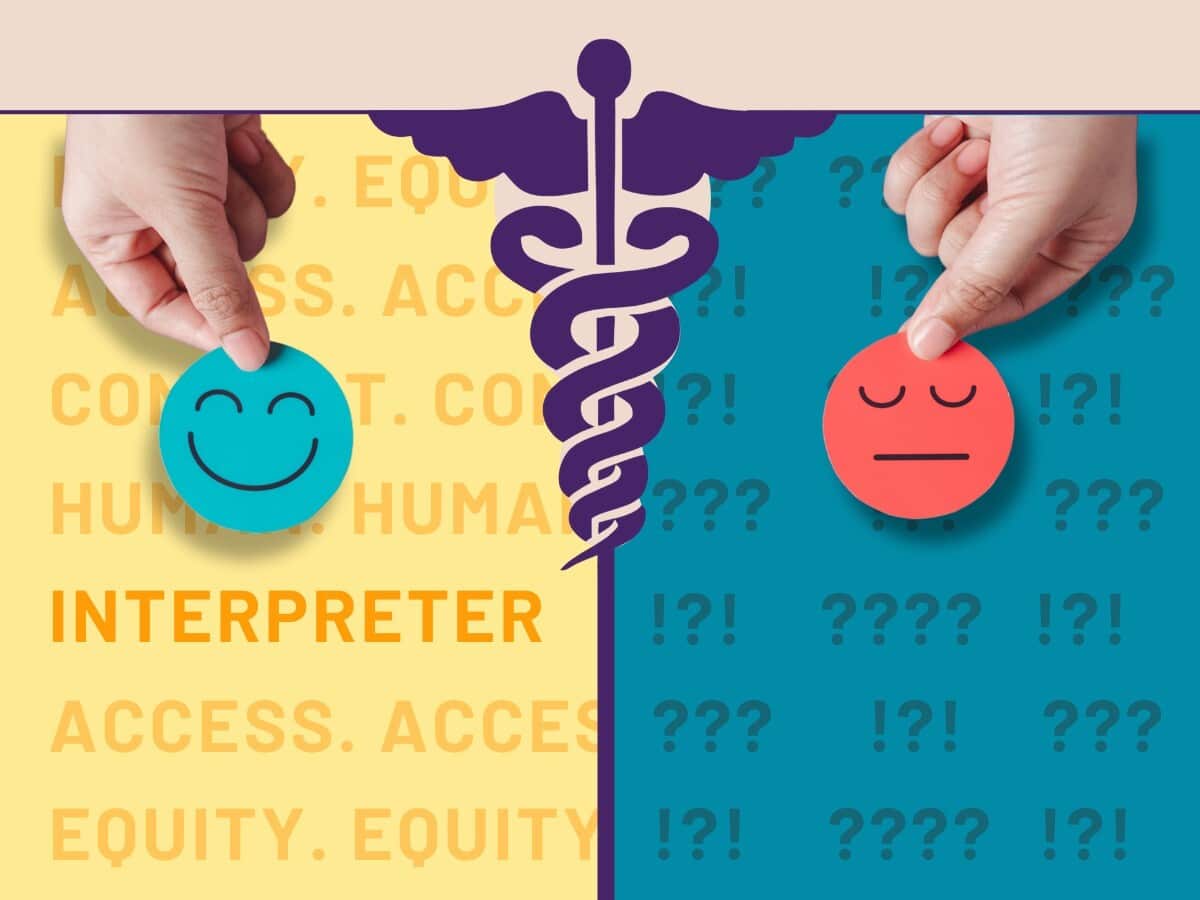Introduction: Telehealth Interpreting
Telehealth is supplying health-related services and information through telecommunication technologies. (HRSA) Telehealth has been around for some time, making its first real appearance in the 1950s. However, telehealth has really begun to grow in recent years, particularly with the COVID-19 pandemic in 2020. Telehealth gives patients the ability to speak to providers without having to go into the doctor’s office. This is a convenient option for individuals who may be sick, and want to avoid spreading their illness, or for situations when a doctor’s office is closed, such as during a holiday or over a weekend.
While the advantages of telehealth are numerous, patients who do not speak the same language as their healthcare provider may still encounter language barriers. Interpreting services in healthcare are crucial in ensuring health equity for every single patient. These interpreting services play a vital role in facilitating effective communication between the patient and the healthcare provider, bridging the language gap and ensuring that patients receive the care they need, regardless of their language proficiency. Let’s take a look at the best practices and benefits for telehealth interpreting.
The Role of Interpreters in Healthcare

Effective communication is extremely important in a healthcare setting. There are challenges all throughout a patient’s healthcare journey that non-English speaking patients face every day. Medical interpreters are there to facilitate doctor-patient communication to ensure both parties understand one another. There can be a lot of medical jargon that even a patient who speaks the same language as the provider can find confusing. Miscommunications can happen easily and it only takes one to put a patient and provider down the wrong medical path, which could lead to fatalities. Interpreters in healthcare, and especially telehealth, where all communication is done through technology, are crucial for facilitating understanding between both parties.
Traditional Interpreting vs. Telehealth Interpreting
Traditional interpreting, also known as face-to-face or in-person interpreting, consists of the interpreter being in the same room as the patient and provider. While traditional interpreting comes with its share of pros, such as interpreting non-verbal communications more accurately, there are also cons, such as travel requirements, which can be expensive, and long wait times.
Telehealth interpreting, however, is using telehealth technology to get an interpreter whenever you need one and wherever you are. This can even be done instantly with certain interpreting platforms, significantly cutting down wait times. With many telehealth interpreting services, you can also have the added advantage of using both video and audio. This ensures that not a single non-verbal communication is missed. By leveraging telehealth interpreting, healthcare organizations can improve accessibility and efficiency, ultimately enhancing the quality of care for patients who require language assistance.
Best Practices for Telehealth Interpreting
Telehealth interpreting is a very advantageous, but there are specific best practices that can make it even better. Let’s take a look.
Select Qualified and Trained Interpreters for Telehealth Sessions
 Using telehealth interpreting can be beneficial, but to ensure truly exceptional telehealth interpreting, it is crucial to have interpreters who are specially trained and qualified. High-quality interpreters have specific certification requirements to meet, as well as undergoing continuous professional development in the field of telehealth interpreting. It is important for telehealth interpreters to specialize in the healthcare industry to effectively interpret medical jargon that often confuses patients, even when they do speak the same language as the healthcare provider. Having an interpreter who can explain the medical terminology is necessary in a healthcare setting.
Using telehealth interpreting can be beneficial, but to ensure truly exceptional telehealth interpreting, it is crucial to have interpreters who are specially trained and qualified. High-quality interpreters have specific certification requirements to meet, as well as undergoing continuous professional development in the field of telehealth interpreting. It is important for telehealth interpreters to specialize in the healthcare industry to effectively interpret medical jargon that often confuses patients, even when they do speak the same language as the healthcare provider. Having an interpreter who can explain the medical terminology is necessary in a healthcare setting.
Establish Clear Communication Protocols Between Healthcare Providers, Patients, and Interpreters
One of the most important aspects of telehealth interpreting is for interpreters to bridge the communication gap between patients and providers. This enables clear protocols, precise instructions, and ensures both providers and patients can understand one another. Language barriers happen when patients and providers do not speak the same language. With interpreters to help bridge that language gap, clear communication protocols and information can be shared between everyone involved.
Provide Cultural Competence Training to Interpreters for Effective Communication
The provision of cultural competence training to interpreters is essential for effective communication in telehealth. Cultural competence ensures that interpreters have a deep understanding and appreciation of different cultural norms, values, and beliefs. This enables them to navigate language barriers while also considering cultural nuances, which can greatly impact healthcare interactions.
By receiving cultural competence training, interpreters are better equipped to provide accurate and culturally sensitive interpretations, facilitating meaningful communication between healthcare providers and patients. This training helps promote cultural awareness, respect, and inclusivity in telehealth settings, ultimately improving the quality of care and patient outcomes.
Maintain Patient Confidentiality in Telehealth Interpreting
Maintaining patient confidentiality in telehealth interpreting is crucial for ensuring the privacy and trust of patients in virtual healthcare settings. Interpreters must be knowledgeable about legal and ethical considerations when providing their services in virtual settings. This includes compliance with healthcare regulations and guidelines to protect patient information and maintain confidentiality.
Interpreters need to adhere to strict confidentiality policies and procedures, ensuring that patient conversations and personal health information remain private and secure. By upholding patient confidentiality, telehealth interpreting can maintain the highest standards of professionalism and ethical conduct, promoting a safe and confidential environment for patients to receive the care they need.
Benefits of Telehealth Interpreting

Now that we’ve discussed the best practices when it comes to telehealth interpreting, let’s talk about the benefits. Telehealth interpreting offers numerous advantages. Interpreters in this type of setting help increase accessibility for patients, no matter which language they speak. Ensuring health equity for everyone is not just a luxury, but a fundamental right. Every patient deserves the ability to understand and communicate openly with their healthcare provider.
Telehealth interpreting is also highly efficient. On-demand interpreters can cut down long wait times commonly associated with traditional interpreting. With an interpreter available instantly, whenever and wherever needed, both patients and providers benefit from the flexibility and convenience it offers.
Furthermore, telehealth interpreting ensures accuracy and precision in medical communication. By leveraging telehealth technology, interpreters can utilize video and audio capabilities to capture both verbal and non-verbal cues. This comprehensive approach helps prevent misinterpretations and misunderstandings, as interpreters can accurately convey the intended message, including important medical terminology and instructions. The precise communication facilitated by telehealth interpreting contributes to better patient understanding and reduces the risk of medical errors.
Conclusion
Telehealth interpreting plays a crucial role in ensuring effective communication and health equity for patients who do not speak the same language as their healthcare providers in a virtual setting. By bridging the language gap, qualified telehealth interpreters facilitate clear communication between patients and providers, helping to avoid misinterpretations and potential medical errors. As telehealth continues to grow and evolve, the ongoing improvement and expansion of telehealth interpreting services are essential to ensure inclusive and quality healthcare for all.









